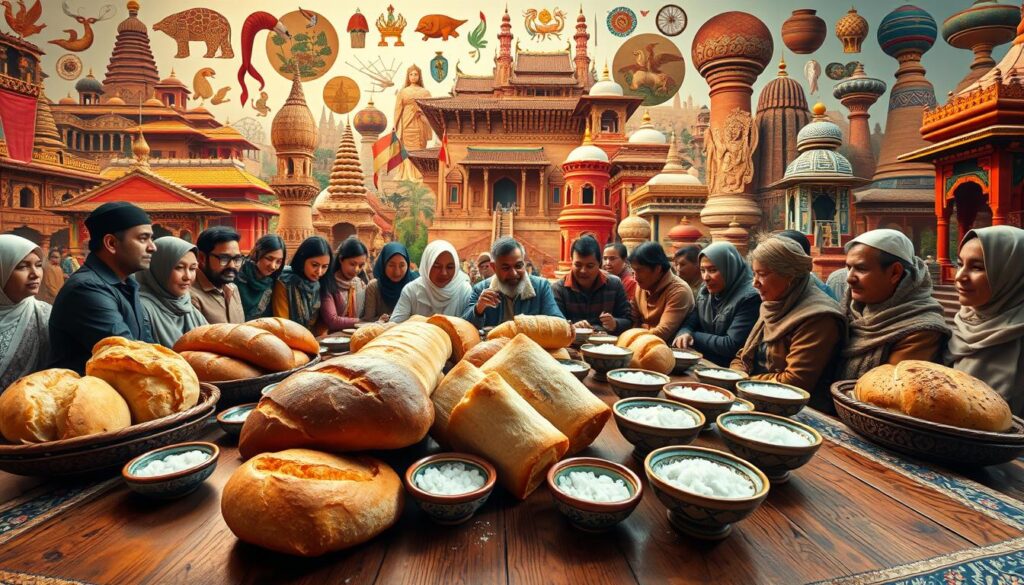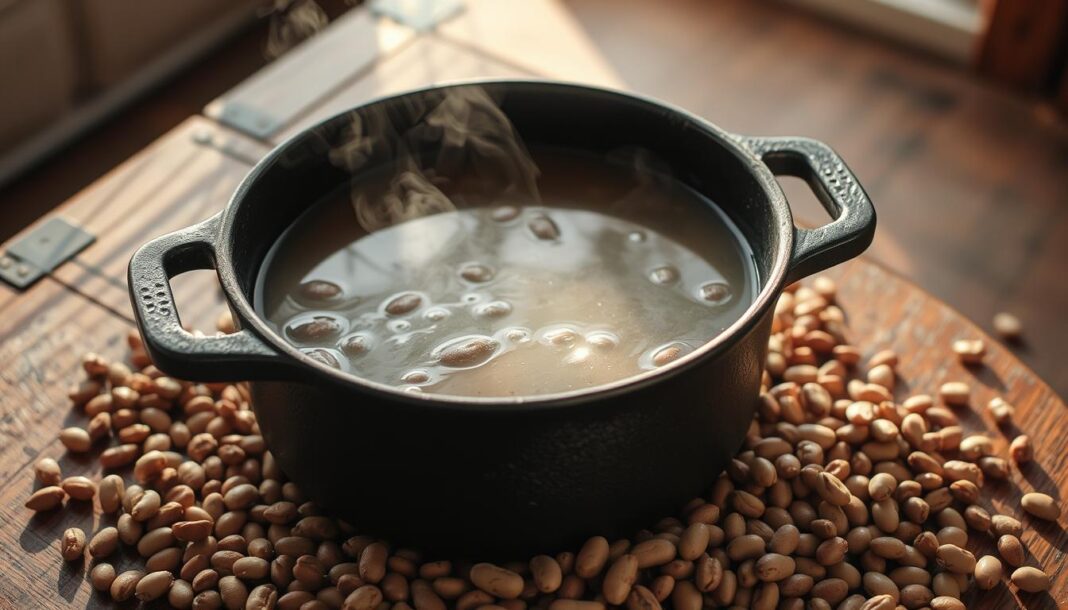Across cultures and continents, the act of offering bread and salt to guests has been a timeless gesture of hospitality. This enduring custom is particularly significant in Slavic countries, yet its presence is also notable in Nordic, Baltic, Balkan, and other European cultures, as well as in Middle Eastern societies. The significance of this duo lies in their historical and symbolic value – salt as a precious commodity that preserved food and bread as the “staff of life.”
The tradition’s persistence through centuries demonstrates its deep-rooted significance, extending beyond mere sustenance to represent fundamental elements needed for human survival and community. As we explore this ancient tradition, we uncover how it continues to resonate in modern times, from diplomatic ceremonies to cultural rituals.
Key Takeaways
- The bread and salt tradition is a widespread custom of hospitality across multiple cultures.
- It symbolizes welcome, friendship, and good fortune.
- The tradition has historical significance, with both bread and salt holding practical and symbolic value.
- The custom continues to be relevant in modern times, appearing in various cultural and diplomatic contexts.
- The tradition represents fundamental elements necessary for human survival and community.
The Origins and Symbolism of the Bread and Salt Tradition
Bread and salt, a duo as old as civilization itself, have been imbued with deep symbolic meanings across various cultures. This powerful combination has been a cornerstone of hospitality, friendship, and protection, transcending its role as a simple food item.
Historical Background
The historical roots of the bread and salt tradition are complex and multifaceted. In Russian culture, bread is associated with hospitality, being the most respected food, while salt symbolizes long friendship, as expressed in the saying “to eat a pood of salt (together with someone)”. According to some Turkic legends, bread and salt were discovered by the grandsons of Japheth, the Islamic ancestor of the Turks. This historical context underscores the significance of bread and salt in forming and maintaining social bonds.

Symbolic Meaning of Bread and Salt
The symbolic meanings of bread and salt are profound and varied. Bread represents life, prosperity, fertility, and the fruits of human labor across numerous cultures. Salt, on the other hand, symbolizes purification, preservation, and protection against evil spirits or bad fortune. Together, they form a dual symbol where bread signifies the sweetness and abundance of life, while salt represents its challenges and preservation. The ritual consumption of bread and salt creates a sacred bond between host and guest, establishing obligations of protection and hospitality considered inviolable. This symbolic power is evident in numerous proverbs and sayings across cultures.
The combination of bread and salt in various customs highlights their importance as a symbol of hospitality and friendship, reflecting a deep-seated ritual that continues to influence people and their customs today.
The Bread and Salt Tradition Across Different Cultures
The tradition of bread and salt is a common thread that weaves through numerous cultures, symbolizing hospitality, prosperity, and good fortune. As we delve into the diverse practices surrounding this tradition, we find that different regions have their unique interpretations and customs.
Slavic Customs and Practices
In Slavic cultures, bread and salt are integral to welcoming guests and marking significant life events. The practice is deeply rooted in the symbolism of bread as a staple food representing abundance and salt as a preservative signifying longevity. For instance, in many Slavic countries, it’s customary to offer bread and salt to visitors as a sign of respect and hospitality.
Middle Eastern and Mediterranean Traditions
The Middle East and Mediterranean regions also have rich traditions surrounding bread and salt. In these cultures, bread is often seen as a symbol of family and community, while salt represents the covenant and loyalty. The act of breaking bread together is a significant social bonding experience, emphasizing the importance of unity and togetherness.
Baltic, Nordic, and Other European Variations
In Finland, Estonia, Latvia, and Lithuania, the tradition of offering bread and salt is associated with new homes, symbolizing a blessing for the inhabitants. Dark rye bread is often used instead of white bread, adding a local twist to the tradition. Similarly, in Hungary, bread is used to ensure the well-being and fertility of the family
These variations demonstrate how the bread and salt tradition has been adapted to fit the cultural and regional contexts, while maintaining its core symbolism of sustenance, preservation, and hospitality. By examining these diverse practices, we gain a deeper understanding of the significance of this tradition across different cultures and countries.
The Bread and Salt Wedding Tradition
As a significant part of many wedding ceremonies, the bread and salt tradition holds profound meaning. This ritual is observed in various cultures, symbolizing the wishes and wisdom of the parents for the newlywed couple’s future together.
Wedding Ceremony Practices
In the bread and salt wedding tradition, bread is given by the parents to the bridal couple as a symbol of sustenance and sweetness in life. It represents the hope that the couple will never know hunger or want, signifying prosperity and abundance in their union. The act of giving bread is a gesture of goodwill, wishing the couple a life filled with plenty.

Meaning Behind the Wedding Ritual
The salt used during the wedding reception signifies that life will not always be easy. It conveys the parents’ understanding that their children will face difficulties, but with perseverance, they will grow stronger as a couple. The addition of wine in this ritual represents joy, celebration, and the hope for a life filled with happiness. Together, bread, salt, and wine symbolize the parents’ wishes for their children’s love and future together.
The bread and salt wedding ritual is a nuanced tradition that acknowledges both the joys and challenges of marriage. It serves as a parental blessing, offering wisdom about partnership while expressing hope for the couple’s future. This tradition is a meaningful way to honor the bride and groom, wishing them a lifetime of love and happiness in their weddings journey together.
- The bread and salt wedding ritual carries profound symbolic meaning, representing the parents’ wishes and wisdom for the couple’s future.
- Bread symbolizes sustenance and sweetness, representing prosperity and abundance.
- Salt represents the challenges the couple will face, teaching them to persevere.
- The addition of wine signifies joy and the hope for a happy life.
Modern Applications of the Bread and Salt Tradition
The bread and salt tradition continues to be relevant in various aspects of modern life. While its origins are rooted in history, this ritual has adapted to contemporary contexts, maintaining its significance across different cultures and societies.
Official State Ceremonies and Diplomatic Visits
In modern times, the bread and salt tradition is still observed during official state ceremonies and diplomatic visits. Diplomats and dignitaries are often greeted with this ritual, symbolizing hospitality and goodwill. For instance, during official visits, hosts offer bread and salt to their guests as a gesture of peace and friendship.
The Tradition in Space Exploration
Interestingly, the bread and salt tradition has also found its way into space exploration. Cosmonauts and astronauts have carried bread and salt on their missions as a symbol of good luck and a connection to their heritage. This unique application highlights the tradition’s versatility and its ability to transcend cultural boundaries.
Cultural Representations in Literature and Media
The bread and salt tradition has been featured in various literary works and media, such as George R.R. Martin’s “A Song of Ice and Fire” series and its television adaptation, “Game of Thrones.” These cultural representations not only introduce this ancient custom to new audiences but also underscore its significance in symbolizing hospitality and sacred bonds. Other authors, like Rudyard Kipling and Rosemary Sutcliff, have also used bread and salt symbolism in their works, further cementing its place in cultural consciousness.
These modern applications demonstrate the enduring relevance of the bread and salt tradition, adapting to new contexts while retaining its core symbolism. As we continue to explore its significance, we find that this ritual remains an integral part of our shared cultural heritage.
Preserving the Bread and Salt Tradition in Contemporary Society
The persistence of the bread and salt tradition in modern times speaks to its deep-rooted significance in human culture and relationships. Despite modernization and globalization, this tradition continues to thrive, adapting to new contexts while preserving its essential meaning and symbolism.
In Bulgaria, for instance, the custom of presenting bread and salt to guests is a significant expression of hospitality. The tradition involves offering a specially made bread called pogacha, which is flat, fancy, and decorated, accompanied by salt. This practice is not only limited to personal interactions but is also observed during official visits, highlighting its importance in both personal and public spheres.
Families and communities are finding innovative ways to maintain this tradition across generations, incorporating it into modern life. The bread and salt ritual serves as a powerful reminder of hospitality’s importance in human connection, offering a counterbalance to the increasing isolation of modern life. It provides a tangible way to express welcome and community, making it a valuable practice in today’s fast-paced world.
For many immigrant communities, maintaining the bread and salt tradition is an important link to their cultural heritage and identity. It is passed down to children as a way of connecting them to their ancestral roots, ensuring the continuation of cultural practices. In an era of renewed interest in traditional crafts and food ways, this tradition offers an opportunity to connect with historical practices through the making of special bread and the performance of meaningful rituals.
As we move forward, it is clear that the bread and salt tradition will continue to be a vital part of our cultural landscape, symbolizing love, family, and community. By preserving this tradition, we not only honor our heritage but also foster a sense of belonging and connection in our increasingly globalized world.


